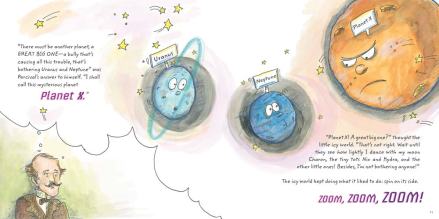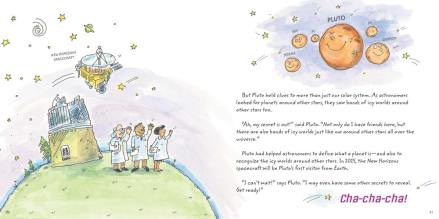About the Holiday
Whether you believe Pluto should be considered a planet or not, it’s hard not to love that little celestial body. Today’s holiday celebrates the discovery of Pluto in 1930 and our continued fascination with this outlying neighbor.
Pluto’s Secret: An Icy World’s Tale of Discovery
Written by Margaret A. Weitekamp with David DeVorkin | Illustrated by Diane Kidd
From the beginning of the solar system, a little icy world circled the sun, far away from the other planets, and held “a secret—a clue about something that exists in the solar system and the universe.” It was a long time before science was able to see this little world, and so it’s secret remained…well…secret. That was okay with the celestial body because “it was busy dancing with its moons.” In the early 1900’s, though, Percival Lowell, thought that there must be another body pulling on the orbits of Uranus and Neptune. Astronomers used the Lowell Observatory that he had built in Arizona to search for a new planet.

Image copyright Diane Kidd, text copyright Margaret A. Weitekamp with David DeVorkin. Courtesy of Abrams Books for Young Readers
Lowell believed that scientists would find a giant planet disrupting the paths of the two planets. He decided to call it Planet X. But the icy world thought, “‘That’s not right. Wait until they see how lightly I dance with my moon Charon, the tiny tots Nix and Hydra, and the other little ones! Besides, I’m not bothering anyone!’” Astronomers looked and looked for Planet X. Even after Percival Lowell died in 1916, they kept on searching. Finally, in 1930 Clyde Tombaugh discovered what they had all been looking for with a powerful telescopic camera.

Image copyright Diane Kidd, text copyright Margaret A. Weitekamp with David DeVorkin. Courtesy of Abrams Books for Young Readers
People from all over the world offered names to replace Planet X. Someone thought Minerva would be good. Others came up with Cronus, Zeus, Atlas, even Lowell. “‘Yuck, thought the little world.’” Yuck, thought the astronomers. Finally, an 11-year-old girl from England suggested the planet be named Pluto after the Roman god of the dark underworld because it was so far away from the sun. Everyone liked that idea.
But right from the start, Pluto was different from the other planets. As more powerful telescopes were invented, scientists could see that Pluto had friends that were more like it than were the other 8 planets. What’s more, these icy-world friends occupied the same area, which came to be called the Kuiper belt. Many astronomers began to talk among themselves and even wondered if Pluto “should even be called a planet.”

Image copyright Diane Kidd, text copyright Margaret A. Weitekamp with David DeVorkin. Courtesy of Abrams Books for Young Readers
But what was a planet, really? “Amazingly, no one had ever set up rules about what a planet was—or was not.” The astronomers then decided on several criteria. Pluto met most of them—but it did not meet a very important one. Since Pluto did not fulfill all the requirements, the astronomers proclaimed that it was not a planet after all. Kids and people who had grown up thinking of Pluto as a planet were sad and protested this change. But Pluto didn’t mind. It thought, “‘I’m not a planet. I’m the first example of something new. I’m one of many icy worlds on the edge of the solar system.’”
Now that astronomers have gotten to know Pluto in a new way, they’ve found that other icy worlds exist around other stars. The discovery has opened up new possibilities for the future of space exploration.

Image copyright Diane Kidd, text copyright Margaret A. Weitekamp with David DeVorkin. Courtesy of Abrams Books for Young Readers
Extensive back matter includes a discussion of the people and telescopes behind the discovery of Pluto, a who’s who of planets and astronomers, a glossary of terms, suggested resources for readers, and a note from the Smithsonian Museum.
Pluto, it seems, is a very garrulous little planet, and Margaret A. Weitekamp and David DeVorkin are privy to its thoughts, much to the benefit of young readers. In this delightful, conversational history of Pluto, kids learn about the people, ideas, and facts surrounding the icy world in language they understand peppered with humor and suspense. Pluto’s reactions to what it “sees” going on down on Earth is sure to make little scientists giggle and pique their interest in future space discoveries.
Diane Kidd’s bright, cartoon-inspired illustrations immediately form a bond with the book’s young audience. Little Pluto, dancing with its moons, giving raspberries to names it doesn’t like, and playing along a different orbit, is just one of the kids—happy to hang out with its other icy worlds instead of being a full-grown planet. Lots of action, clear portrayals of scientific concepts, and accessible layouts and typography, make this a book kids will love to learn from.
Ages 6 – 10
Harry N. Abrams, 2013 | ISBN 978-1419704239
Learn more about Margaret A. Weitekamp, her work for the Smithsonian’s National Air and Space Museum, and her books here!
Find out more about David DeVorkin and his work at the Smithsonian’s National Air and Space Museum here!
Discover more about Diane Kidd, her books, and her illustration work on her website!
Pluto Day Activity

Out of This World Spaceship Coloring Page
Zoom across this printable Out of This World Spaceship Coloring Page and create the colors of space as you imagine them.
Picture Book Review


